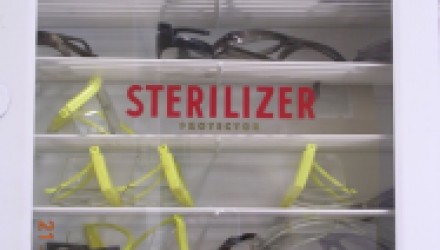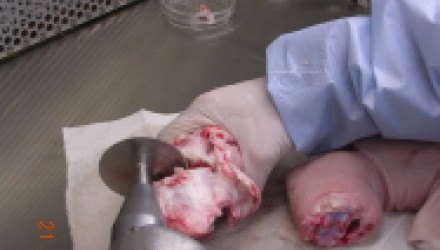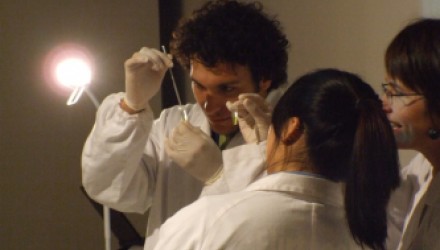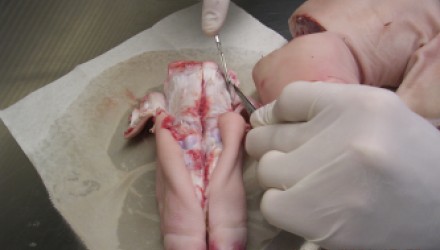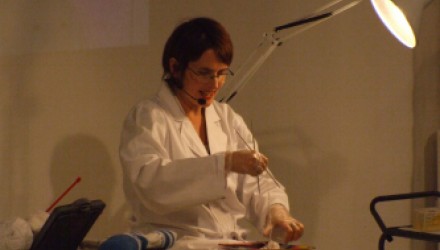
Dr Egg Digital Transmedia Project
In a magical world of scientific discoveries where even the impossible seems real, three children with special powers discover the greatest lessons of all...
Click here to explore the transmedia project based on the AWGIE Award-winning theatre show by Catherine Fargher.
Projects
BACKGROUND
User login
Bio Home: the Chromosome Knitting Project
Catherine Fargher
Faculty of Creative Arts University of Wollongong
Faculty of Creative Arts Gallery University of Wollongong
Experimental Art Foundation Adelaide
Australian Centre for Photography Sydney
Electrofringe Newcastle
Writer/Performer/Devisor/Producer Catherine Fargher
Production Manager Jessica Ellis
Sound Design Terumi Narushima
Direction and Corporeal Dramaturgy Nikki Heywood
Textual Dramaturgy Noelle Janascewska & Merlinda Bobis
Visual Dramaturgy Brogan Bunt & Virginia Hilyard
Plasma Screen Performers Catherine Fargher, Dennise Cepeda & Terumi Narushima
Composition Terumi Narushima, Matthew Fargher, Ian Moorehead & Catherine Oates
Video Footage Catherine Fargher, Virginia Hilyard, Cominos Zervos & Tim Watts
Live Camera Operation Jessica Ellis
Sound Recording and Editing Catherine Fargher
Video Editing Catherine Fargher, Virginia Hilyard & Peter Oldham
Video Documentation Peter Oldham
Stills Photography Russell Emerson
Web Design/Plasma Screen Design/Branding Jessica Ellis, Vincent Bicego, Greg Clout & Robert Dinnerville
Design and Technical Support Russell Emerson (University of Sydney, Centre for Performance Studies),
Didier Balez, Alistair Davies, Aaron Hull, Virginia Hilyard & Brogan Bunt
Installation Space Design Greg Clout & Jessica Ellis
Knitted Elements Pamela Drysdale
BioHome: The Chromosome Knitting Project is a hybrid performance/installation incorporating live ‘wet biology’ practices in a contemporary biotech display home. The installation features video, interactive sound, live performance and text. ‘Wet biology’ procedures such as plant DNA extraction and live insect cell culturing are used to explore reproductive futures and biotechnologies.
Before entering the installation space audience members are introduced to laboratory safety procedures and biohazards, and they are invited to undertake safety training and wear ‘PC2’ lab safety clothing. Upon entering the gallery the audience sees several domestic spaces: a kitchen tabletop, a bassinette, a chair with knitting and a bed with a screen. It is only when they inspect more closely that this domesticity is disrupted by the intriguing and uncomfortable presence of biotech products, including live caterpillar cell cultures, salmon DNA fibres, pea seedling DNA and IVF hormone products.
The blurring of lines between laboratory and domestic procedures aims to heighten the awareness and discomfort the audience may feel about incorporation of biotech products in our daily lives. They are encouraged to investigate and interrogate these technologies and their impact on human, social and environmental futures and contemporary kinship systems.
Knitting is a central metaphor in the performance, highlighting similarities between the use of patterns and stitches in knitting to the basic techniques of biotechnology or genetic engineering, i.e. working with DNA as the ‘building blocks of life’. Knitting is also a metaphor for human reproduction. The performance includes a demonstration of knitting fibres extracted from salmon DNA.
For the music, a number of standard pattern stitches used in knitting are represented as patterns in sound. These sequences are realised using inharmonic timbres based on band patterns that result from a technique used by molecular biologists to analyse DNA known as gel electrophoresis.
The biological collaborations were developed as a result of the artists’ participation in the SymbioticA Wet Biology Workshop, School of Anatomy and Human Biology at the University of Western Australia, and continued with the School of Biology, University of Wollongong.
